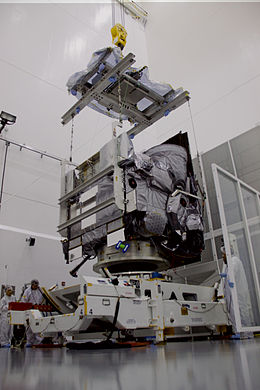EWS-G2 (Electro-optical Infrared Weather System Geostationary)[1] is a weather satellite of the U.S. Space Force, formerly GOES-15 (also known as GOES-P before becoming operational). The spacecraft was constructed by Boeing, and is the last of three GOES satellites to be based on the BSS-601 bus. It was launched in 2010, while the other BSS-601 GOES satellites—GOES-13 and GOES-14—were launched in May 2006 and June 2009 respectively.[2] It was the sixteenth GOES satellite to be launched.
 The GOES-15 satellite during pre-launch processing. | |
| Names | GOES-P GOES-15 (before September 22, 2023) |
|---|---|
| Mission type | Weather satellite |
| Operator | NOAA / NASA |
| COSPAR ID | 2010-008A |
| SATCAT no. | 36411 |
| Mission duration | 10 years (planned) Elapsed: 14 years, 8 months, 18 days |
| Spacecraft properties | |
| Spacecraft type | GOES-N series |
| Bus | BSS-601 |
| Manufacturer | Boeing ITT Corporation |
| Power | 2.3 kilowatts from solar array |
| Start of mission | |
| Launch date | 4 March 2010, 23:57 UTC |
| Rocket | Delta IV-M+(4,2) |
| Launch site | Cape Canaveral, SLC-37B |
| Contractor | United Launch Alliance |
| Orbital parameters | |
| Reference system | Geocentric |
| Regime | Geostationary |
| Longitude | 128° West |
| Slot | GOES-West |
| Semi-major axis | 42,166 kilometres (26,201 mi) |
| Perigee altitude | 35,791.0 kilometres (22,239.5 mi) |
| Apogee altitude | 35,800.4 kilometres (22,245.3 mi) |
| Inclination | 0.2° |
| Period | 1,436.2 minutes |
Launch
editGOES-15 was launched atop a Delta IV-M+(4,2) rocket flying from Space Launch Complex 37B at the Cape Canaveral Air Force Station.[3][4] The launch occurred at 23:57 UTC on 4 March 2010, forty minutes into a sixty-minute launch window. Upon reaching geostationary orbit on 16 March, it was redesignated GOES-15.[4][5] On 6 December 2011, it was activated as the GOES-West satellite, replacing GOES-11.[6]
Design
editAt launch, the mass of the satellite was 3,238 kilograms (7,139 lb). It has a design life of ten years. Power is supplied by a single gallium arsenide solar panel, which provides up to 2.3 kilowatts of power. A 24 cell nickel hydrogen battery is used to provide power when the satellite is not in sunlight.[7] Instruments aboard GOES-15 include a five channel multispectral imager to capture visible light and infrared images of the continental United States, a sounder to take readings of atmospheric temperature and moisture, a solar x-ray imager to detect solar flares, and instruments to monitor the magnetosphere, cosmic background radiation and charged particles.[7]
Operations
editNOAA began to transition GOES-15 out of operational status at the GOES-West position in late 2018 to replace it with GOES-17.[8][9] GOES-15 began an eastward drift maneuver on 29 October 2018 to 128° W, with all of its sensors still functioning.[9] GOES-15's drift is intended to provide additional separation from GOES-17 to prevent communication interference. GOES-15 drifted east at a rate of 0.88° per day until 7 November 2018, when it reached its new operating location of 128° West. Once GOES-17 reached its assigned longitude on 13 November 2018, additional tests were performed; provided that testing goes well, GOES-17 will become operational as GOES-West on 10 December 2018.[9] Both GOES-17 and GOES-15 operated in tandem through early 2020 to allow for assessment of the performance of GOES-17 as the GOES-West operational satellite.[9] On March 2, 2020, GOES-15 was deactivated and moved to a storage orbit, with plans to re-activate it in August 2020 to back up GOES-17 operations due to a known flaw causing many sensors to become unreliable at night during certain times of the year.[10][11] On 22 September 2023 the satellite's ownership was officially transferred to the U.S. Space Force, taking its current designation as part of the EWS-G network. As a consequence, the spacecraft has started drifting over the Indian Ocean to reach its new assigned orbit and it's scheduled to become operational in November 2023.[1]
Media
editReferences
edit- ^ a b "Space Force accepts second weather satellite through NOAA partnership". U.S. Space Force. 22 September 2023. Retrieved 26 September 2023.
- ^ Krebs, Gunter. "GOES N, O, P, Q". Gunter's Space Page. Retrieved 4 March 2010.
- ^ "GOES-P Launch Blog". NASA. Archived from the original on 2010-03-04. Retrieved 2010-03-04.
- ^ a b Ray, Justin. "Mission Status Center". Delta Launch Report. Spaceflight Now. Retrieved 19 March 2010.
- ^ "LIVE: Delta IV set to launch GOES-P weather satellite". NASAspaceflight.com. 4 March 2010. Retrieved 4 March 2010.
- ^ "NOAA activates GOES-15 satellite; deactivates GOES-11 after nearly 12 years in orbit". NOAA. Retrieved December 7, 2011.
- ^ a b "GOES-P Mission Operations Booklet" (PDF). United Launch Alliance. Archived from the original (PDF) on 17 July 2011. Retrieved 4 March 2010.
- ^ "Get Ready to Drift: GOES-17 Begins Move to Its New Operational Position | NOAA National Environmental Satellite, Data, and Information Service (NESDIS)". www.nesdis.noaa.gov. Retrieved 28 July 2020.
- ^ a b c d "GOES-17 Transition to Operations │ GOES-R Series". www.goes-r.gov. Retrieved 2018-10-25.
- ^ "GOES-16/17 Transition". NOAA. 2020-02-19. Retrieved 2020-03-03.
- ^ "GOES-15 is no longer sending data". CIMSS. 2020-03-02. Retrieved 2020-03-03.
External links
edit- GOES-P Press Kit
- GOES Timeline The History of Geostationary Satellites. From the launch of SMS-1 in May 1974 through the launch of GOES-13.
- GOES-15 image examples on the CIMSS Satellite Blog